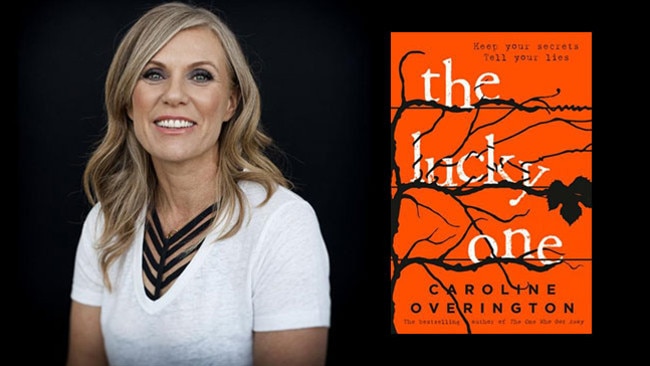The Lucky One: Caroline Overington buries secrets amid the bones
In Caroline Overington’s The Lucky One a mystery is unearthed when a bobcat desecrates a family graveyard.
When the extended Alden-Stowe clan decides to sell its decrepit, heavily mortgaged heirloom estate to a billion-dollar company, it’s supposed to be a straightforward transaction: pots of money in exchange for land earmarked for large-scale agricultural works.
But the developers ignore certain sale conditions, such as not razing the majestic oak trees surrounding the property, not vandalising the adjoining cemetery, not destroying the historic house. Their dereliction opens wide a hitherto hidden tale of intra-familial squabbling and malicious intent.
In Caroline Overington’s latest novel, The Lucky One, several family secrets have been kept firmly intact for many years. It’s only when a bobcat desecrates a graveyard and reveals a fresh corpse, slightly singed, that the rot finally is revealed. It will take a while, though, before the truth starts wriggling out like upturned earthworms.
Set in the picturesque hills of Paso Robles, in California’s wine country, the book spans three generations and features a gothic setting in a 100-year-old family pile (a ramshackle castle no less). There will be a second body, this one quite a bit older, and recovered in an unlikely location somewhere in the dusty recesses of this ivy-covered stone mansion, with its drawbridge and dry, overgrown moat.
And later, deaths summarily dismissed as accidental will need reclassification. You may think you know whodunit and even whydunit, but The Lucky One will blindside you in the final sections, when unexpected blood ties, alliances and collusions come to light.
As someone murmurs within the pages, “You can bury bones but not secrets.”
The main character is Eden, the 17-year-old granddaughter of octogenarian Owen James Alden-Stowe III, top of the family tree. He is not in robust mental or physical health but, unfortunately for some, still very much alive and very much attached to his castle. That’s not changed by the fact he and members of the extended clan are staying at a more modern adjoining property called the Glass Pavilion, a showpiece as uncluttered and polished as the old homestead is dusty and crumbly.
All of Owen’s direct descendants are beneficiaries of a deed that stipulates the sale of Alden Castle is possible only through unanimous agreement. Cue extended family members grappling for control and a concerted effort by Eden’s mercurial and impecunious single mother, Jesalyn, to secure consent from all parties to sell.
It’s a tale of generational distrust and rivalry, but ultimately of greed: of vultures descending for their share of the spoils and the fallout when a deserving claimant is left out of the trust.
This is Overington’s eighth novel and, like several of its predecessors, it’s a psychological thriller. (She also has three nonfiction books and is a journalist with The Australian.)
Though placed in contemporary time (social media is mentioned), there’s something decidedly old-fashioned about this book. Perhaps it’s the looming presence of the castle, reminiscent of the cosy, closed-set mysteries of Agatha Christie. There are also several stock figures, so at times it feels as though Overington is playing Cluedo.
There’s the patriarch in the throes of dementia (Colonel Mustard?); the avaricious Botoxed blonde widow (Mrs Peacock?); the ever-dutiful housekeeper (Mrs White?); the blushing young adult (Miss Scarlett?). Overington moves them around like counters in the classic board game.
Apart from the teenager, who has room to test the limits beyond her role as manipulated ingenue, the rest of the cast (including an uncle, aunt, cousins and great-aunt) seem ancillary to the plot. A more fleshed-out account of individual personalities would have served better in terms of character development.
The book is structured like a four-act play. The beginning involves the discovery of the partially decomposed body and the start of police investigations; the middle flips back to explore events leading up to an unorthodox use of an outdoor pizza oven; the third and final chapters cover the trial and the great reveal. A bit too much of the narrative is concentrated on the long middle section, which tends to flatten the initial suspenseful set-up and make the last few chapters feel a bit rushed.
Not everything is wrapped up in a tidy bow: there are some loose ends and a rather ominous final page. If you like your thrillers with corpses in varying stages of decay, with seemingly clear motives for murder muddied by shock-horror twists at the end, The Lucky One delivers. Note, however, to make guessing the identity of the perpetrator even trickier than a Cluedo game, there’s no mention of candlesticks, revolvers, ropes, daggers or lead pipes.
Caroline Overington will be at the Sydney Writers Festival, May 22 to 28.
Thuy On is books editor of The Big Issue.
The Lucky One
By Caroline Overington
HarperCollins, 336pp, $32.99




To join the conversation, please log in. Don't have an account? Register
Join the conversation, you are commenting as Logout